Guest Post - Gut Healing and Lactofermentation
Today I have a guest post from KerryAnn Foster. KerryAnn shares her personal experience with gut problems and also healing. She also shares about lactofermentation and why doing it properly can be so beneficial to those of us in need of gut healing. Don’t miss the discount code she is offering at the end of this post for her lactofermentation class!
I have learned so much from KerryAnn about fermentation and am learning more all the time. This class will be a great way to get your healing to the next level. If you are on GAPS and not fermenting because you are intimidated by it or because your ferments keep failing this will be a great way to get started with plenty of resources for the novice and experienced fermenter alike. -PattyLA
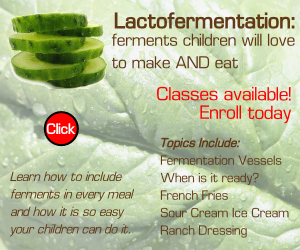 ——-
——-
Lactofermentation is a favorite topic of mine. These days, I ferment just about anything that isn’t nailed down in my kitchen. There are many reasons why I have such a love for fermentation. I appreciate the ability of a properly prepared ferment to give me large amounts of probiotics, digestive enzymes, vitamins, minerals and more. After my experience, I believe anaerobic fermentation should be a cornerstone of treatment for anyone healing their gut.
KerryAnn’s Story
Six years ago, I became seriously ill. I was eventually diagnosed with celiac disease, multiple food intolerances, adrenal fatigue, heavy metal poisoning and more. I was so ill I began wasting and I dropped 60 pounds in ten weeks. The doctors had no answers and told me it was all in my head. At the time, I had been on a real food diet including only soaked grains and raw dairy for four years. The GAPS diet and other means of gut-healing weren’t available or widely known in 2006, so I had to go it on my own. I designed my own gut healing protocol based on the research I could find at the time, and using digestive enzymes and probiotics were two of the four cornerstones of that program.
I continued to consume ferments made in popular vessels, such as the mason jar, but I found myself still in need of the mega-doses of enzymes and probiotics in order to be able to function without all-day nausea and diarrhea. I found it a frustrating experience.
Every morning, I would wake up about 5am out of a dead sleep, sit straight up and hope I could make it to the toilet in time, the diarrhea and vomiting would hit me so hard. I slept on my back with a garbage can between my knees, in a nightgown with no underwear and even then there were many mornings that I’d wake up going at both ends, violently, to the point I regularly would burst blood vessels throughout my body. I had no warning in the mornings and I often couldn’t make it to the bathroom in time. That fun would continue all day at that same level if I hadn’t had my probiotic pills and enzyme powders- uncontrollable diarrhea and nausea and vomiting so bad I threw up forty or more times a day, every day. If I moved my head, I threw up.
If I did take the probiotics and enzymes, the insane power puking and uncontrollable diarrhea would be limited to first thing in the morning and I would not suffer as severely through the rest of the day, but it would still be present to varying degrees. I would have some warning of the diarrhea. The nausea, while always present, wasn’t as strong and I would vomit less. I could move around a little without power puking.
I was isolated in my home, unable to leave except for trips to a doctor or the ER for rehydration. If either of my two toddlers climbed on me, I threw up. I lived on a mattress on my living room floor, often unable to even sit up. At my worst, I could not crawl 20 feet to the bathroom without panting. It was a dark, scary time. We were unsure for many weeks if I would live or die.
What made the change for me? I switched to fermenting in a Harsch crock during this time period and after just a couple of weeks, I began improving. I was shocked because the improvement was fairly rapid to go from dog sick around the clock to only having it in the mornings. After a couple more weeks, I accidentally ran out of digestive enzymes. I panicked, convinced that I was going to regress into debilitating diarrhea and nausea all day. However, I was shocked to find that I did not. So the enzymes I ordered in a panic arrived at my house a couple of days later via express mail, only to sit on my counter untouched. When my probiotics ran out, I discontinued them again with trepidation, only to be relieved to find out I didn’t get worse.
When I lapsed on eating my ferments from the Harsch, I would become ill again and have to go back onto the probiotics and digestive enzymes. My all day illness gradually diminished over a period of several months to only morning nausea, before disappearing. I credit fermentation in a truly anaerobic environment to being the biggest part of my recovery after my experience.
If you’d like to read more of my story and my return to health, you can do so here.
The Benefits
Fermentation under the best conditions provides the fullest benefits. Currently, the two vessels that provide the fullest benefits that are known are the Harsch crock and the Pickl-It. When I later switched to the Pickl-It, I continued to see the same effect as I did with the Harsch. I now use both quite happily.
Let’s look at just a few reasons why anaerobic fermentation vessels are superior to your other options.
Bifidus
Truly anaerobic conditions allow all types of the lactic acid bacteria to flourish. Some of the most healing bacteria, called bifidus, have strains that can not tolerate oxygen exposure. They are extremely sensitive to oxygen, with only a few bifidus strains being able to tolerate what we would consider to be small amounts.
If you are familiar with BioKult, you will see that it contains multiple bifidus strains. There is much in the way of research behind the benefits of bifidus on a number of health problems. I believe one of the two reasons why I healed on a true anaerobic method when mason jar ferments didn’t work was due to the bifidus content. If you’d like to read more about bifidus, click here.
Mold
Mold is a common problem in fermentation that isn’t anaerobic. First, if your ferments mold, you do know that it is not anaerobic, because mold needs oxygen to grow. Mold showing up on a ferment will show you that you’re not getting the bifidus and other beneficial probiotics that are strictly anaerobic.
If you are gut or otherwise health compromised, I do not believe it wise to consume any known amount of mold. Because mold puts tendrils all through a soft or liquid food before the fuzz shows up on top, if you scrape off the mold and eat something anyway, you are consuming the tendrils. I believe this puts an added burden on your body, which slows down the healing process.
Because I live in a humid area of the Southeastern US, I had repeated problems with my mason jar ferments molding and going soggy, limp, slimy and nasty. When I switched to a Pickl-It, those problems ended because bad bacteria do not grow in an oxygenless environment at a low pH. That change alone saved me much in the way of heart-ache and wasted money from having to throw out bad ferments. If you’d like to read more about mold, click here.
Oxidation
Consuming oxidized food creates free radicals in both the ferment and the body. Those free radicals do great amounts of damage before they stabilize. Free radicals are greedy little thieves that rip electrons off of molecules in an effort to stabilize themselves. They make their victim molecule unstable, which then goes searching for another molecule to rip off and a chain reaction starts. When it happens in your body, this chain reaction causes cell death- if you’re lucky. If they don’t kill the cell, the injury can cause mutations and DNA problems- that would be unlucky. When that damaged cell reproduces, both of the new cells it creates has the same problem. Free radicals are also known for causing cells to speed up their replication rates, a known issue in the development of tumors and cancer. Free radicals are thought to be responsible for many health problems including heart disease, premature aging, Alzheimers and many more illnesses.
If any browning occurs in your ferment, you should discard it. The characteristic browning of food doesn’t happen until far along in the oxidation process. You do not want to place the added burden of trying to get rid of free radicals on your body while you are trying to heal. If your ferments brown, know that they are not in an airtight container. If you’d like to read more about oxidation, click here.
These three issues are only the tip of the iceberg in the differences between anaerobic and oxygenated ferments. If you are trying to heal your gut and mason jar ferments are not working for you, if you want to make sure mold isn’t an issue in your ferments or you are having trouble with mold, slime or other causes of failure, I encourage you to consider trying a Harsch or a Pickl-It. The differences in the content of the different types of ferments might be what makes the difference for you, as it did for me. The difference was no less than astounding in my health, my recovery and my current quality of life.
Today, I launch a lactofermentation class where you can learn how to ferment many foods via anaerobic methods. As a bonus, you will receive access to Kitchens Resurrected: A Real Food Cooking School as long as you remain a member. Readers of Loving Our Guts can receive 20% off with coupon code “GUTS” through Friday, July 27th.
 KerryAnn Foster writes real food, gluten and dairy-free recipes that are kid-happy and husband-friendly. She lives in Asheville, NC with her husband, Jeff, and their two kids. She blogs at Cooking Traditional Foods and has written multiple books, eCourses and eBooks. She writes the longest running traditional foods Menu Mailer available, now in its sixth year. She founded Nourished Living Network, a network for traditional food bloggers, in 2011. KerryAn has ten years of traditional foods experience and is a former Weston A. Price Foundation chapter leader.
KerryAnn Foster writes real food, gluten and dairy-free recipes that are kid-happy and husband-friendly. She lives in Asheville, NC with her husband, Jeff, and their two kids. She blogs at Cooking Traditional Foods and has written multiple books, eCourses and eBooks. She writes the longest running traditional foods Menu Mailer available, now in its sixth year. She founded Nourished Living Network, a network for traditional food bloggers, in 2011. KerryAn has ten years of traditional foods experience and is a former Weston A. Price Foundation chapter leader.




2 Comments
Trackbacks/Pingbacks
- Fermentation Friday: Why I Won’t Ferment Without A Separate Airlock Part I | Cooking Traditional Foods - [...] From the research I have listed in todays post coupled with the research and experiences I’ve discussed in my …








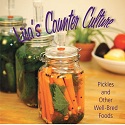

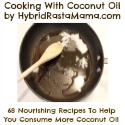



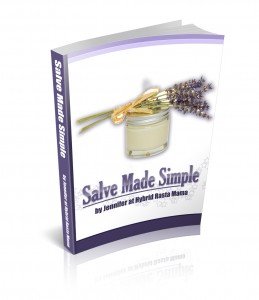
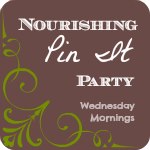

Awesome post!! Couldn’t have come at a better time!! So I can’t afford anything other than a mason jar at this point, what are some things I can do to prevent oxidation or molding?
There really isn’t any way to prevent oxidation and molding in a mason jar ferment. That is the risk of fermenting open to the air. Pickl-it jars start pretty cheap (much cheaper than harsch crocks). The smallest one is just $23. So saving up for one may be your best option. Some ferments may be ok in a Fido jar but you are running the risk of the jar exploding and of having bad gasses build up in the jar. Perhaps that is still better than a mason jar? I don’t now if anyone has looked at that scientifically to tell you how much it hinders the ferment to be in a fido jar, just that it is best in an anaerobic jar. Several stores have had sales on Fido bars recently. Crate And Barrel, Sur La Table and Zulily have all had sales. I don’t know if any are still active but that can be a good way to get a jar(s) cheaper and get started.